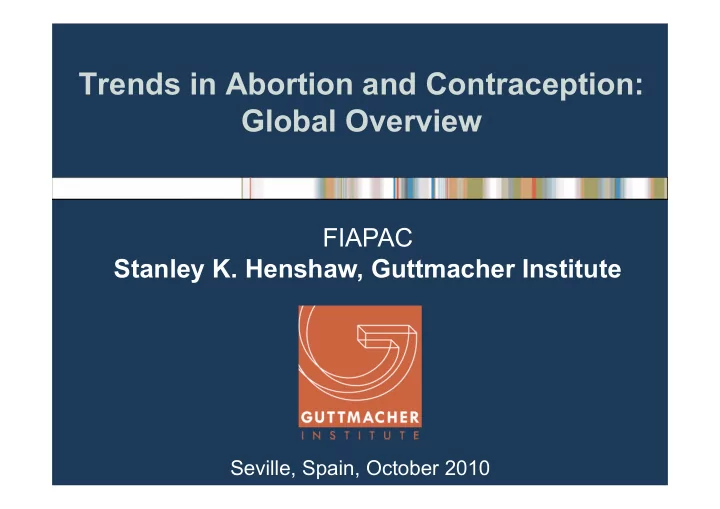

Trends in Abortion and Contraception: Global Overview FIAPAC Stanley K. Henshaw, Guttmacher Institute Seville, Spain, October 2010
Sources • Legal status of abortion: R. Boland and L. Katzive, Development in laws on induced abortion: 1998-2007, International Family Planning Perspectives , 2008, 34(3):110-120; press reports, and factsheets from the Center for Reproductive Rights. • Abortion data: G. Sedgh et al., Induced abortion: estimated rates and trends worldwide, The Lancet , 2007, 370:1338-1345; and data compiled by the Guttmacher Institute. • Contraceptive use: United Nations, Department of Economic and Social Affairs, Population Division. World Contraceptive Use 2009 (POP/DB/CP/Rev2009) (wall chart) (http://www.un.org/esa/population/ publications/WCU2009/Data/UNPD_WCU_2009_Contraceptive_prevalence_met hod.xls.); and World Contraceptive Use 1998 (http://www.un.org/esa/population/pubsarchive/wcu/fwcu/htm).
World’s population according to the law governing abortion 26% Abortion permitted : 40% On request Socioeconomic Mental health Physical health 10% Save life only 4% 20%
Countries with major changes in laws governing abortion since January 2005 Less restrictive More restrictive • Colombia Several Mexican states ● • Ethiopia Nicaragua ● • Mexico City • Niger • Portugal • Spain • Swaziland • Thailand • Togo • Victoria (Australia)
Almost 42 million abortions occurred worldwide in 2003 Millions of abortions 50 40 42 35 30 20 10 7 0 World Developed Developing countries countries
Abortion rates of developed and developing countries, 2003 Abortions/1000 women 15-44 50 40 30 29 26 20 10 0 Developed countries Developing countries
Legal status of abortions, 2003 Millions of abortions 50 40 42 30 20 22 20 10 0 World Legal Illegal
Number of abortions by region, 2003 Millions of abortions 50 40 30 26 20 10 6 4 4 2 0 0 Asia Africa Europe Latin North Oceania America & America Caribbean
Abortion rates by region, 2003 Abortions/1,000 women 15–44 50 40 30 31 29 29 28 20 21 10 0 Africa Asia Europe Latin America North America & Caribbean
Within Europe, rates are highest in the Eastern/Central sub-region Abortions per 1,000 women aged 15–44, 2003 50 40 44 30 20 18 17 10 12 0 Eastern Southern Northern Western
Percentage of married women using any contraceptive method, 1998 and 2007 Percent 1998 100 2007 80 70 70 60 63 62 58 55 40 20 0 World Developed Developing countries countries
Percentage of married women using a modern method, 1998 and 2007 Percent 100 1998 2007 80 60 59 57 56 52 51 50 40 20 0 World Developed Developing countries countries
Percentage of married women using a traditional method, 1998 and 2007 Percent 50 1998 40 2007 30 19 20 11 10 8 7 6 5 0 World Developed Developing countries countries
Developing countries: change in method use, 1998 to 2007 Percent 50 1998 40 2007 30 22 21 20 14 15 9 10 8 4 2 0 Female IUD Pill Condom sterilization
Developed countries: change in method use, 1998 to 2007 Percent 50 1998 40 2007 30 20 18 17 16 14 9 9 10 8 6 0 Female IUD Pill Condom sterilization
Percentage of married women using an IUD by subregion, 2007 World 14% 18% North Africa 1% SubSaharan Africa 37% East Asia 3% South-Central Asia South-East Asia 10% 16% Western Asia Eastern Europe 19% 10% Northern Europe Southern Europe 6% 11% Western Europe 7% Latin America 2% Northern America 0 10 20 30 40
Thank you Stanley K. Henshaw shenshaw@guttmacher.org
Recommend
More recommend